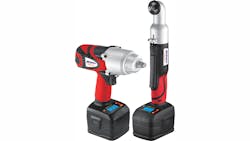Q: My DM wants me to sell more battery-powered tools. I don’t agree. Won’t that eat into my pneumatic tool sales? If not, how do I sell these new power tools?
A: New power tools? Really?! Look around you. Shops are shifting from air tools to battery-powered tools everywhere. We’re not talking glorified electric screwdrivers anymore, we’re talking real power tools with real power. If you don’t shift your thinking, your competitors may be “eating into” both your pneumatic and power tool sales!
I often encourage dealers to follow their customer’s lead. I’m not saying be an order-taker, but be a good listener. More often than not, your customers know what they want and it’s best to wait for them to be ready to go a new direction. This is not one of those cases.
Any customer that does not have a cordless power tool in his toolbox is a prime candidate for you to convert -- now! Why the rush? Each brand of cordless tools uses a proprietary battery pack. Once a customer is committed to a brand, he is also committed to the dealer that carries that brand. That’s because a smart customer wants to be able to swap out battery packs and keep a ready supply of charged back-up batteries that fit all of his tools. Get that first sale, and you virtually lock in that customer for life.
So, a smart dealer like you will profit by being proactive.
Over the last five years, battery technology has advanced quantum leaps. Like most of today’s portable electronics (from laptops to cell phones), battery-powered shop tools have shifted from NiCad (nickel–cadmium) to Li-ion (lithium-ion), says Charles Hung, president of Duro-Fix, manufacturer of ACDelco tools.
Li-ion batteries do not have “memory effect,” says Hung. NiCad batteries lose their maximum energy capacity over time if repeatedly recharged after only being partially discharged -- the battery seems to "remember" the smaller capacity. (Some Ni-Cad charging systems would discharge, then recharge the battery to work around this issue, but added to charging time.) Also, Li-ion batteries tend to be smaller (about half the size), hold a larger charge and provide more working hours than NiCad, says Hung.
“Lithium-ion, along with advancements in motor technology and electronics, has allowed manufacturers to pack a massive amount of power and performance into a compact structure,” says Mike Monteleone, product manager for Milwaukee Tool. “Tools are getting smaller and lighter, and at the same time, outperforming their predecessors.”
A few can even rival air tools, some providing “up to 1,100 ft/lbs of nut-busting torque,” says Monteleone.
Q: What features should I focus on when promoting power tools?
A: A good salesperson focuses on benefits, not just features.
That said, if you’re comparing cordless tools to air tools, the most obvious benefit is that it “unleashes” the technician. Rather than getting tangled in and tripping over an air hose or being tethered to a compressed air line, the technician can work without limits virtually anywhere from the service bay to the parking lot.
To understand one of the other key benefits of batteries over air you just need to open your ears. Cordless tools are considerably quieter. OSHA can and has fined shops that do not take precautions to control undue noise, says Hung. So, a quieter shop can make for a happier shop owner, too.
Battery-powered tools are priced higher than their pneumatic counterparts. So, selling these tools requires that you educate your customers about the short- and long-term benefits of building their cordless tool collection to help them understand the value that comes with the higher price tag. Also, realize your customer will need different power tools for different applications:
Engine Compartment - Generally, torque should never exceed 60 ft/lbs under the hood, says Hung. This helps avoid stripping threads and other major issues.
Wheels and Heavy Duty - In high-torque and heavy duty applications, torque starts at a minimum torque of 60 ft/lbs, and goes all the way to few hundred ft/lbs, says Hung.
Dashboard - “You’re entering the inch-per-pounds mode,” says Hung. A drill driver (instead of an impact wrench like used above) would be the choice to provide lower torque and a physically smaller tool to fit under and around the dash.
Body Shop - Polishers/sanders are more focused on rpm than torque, says Durofix's Hung.
“Productivity should always be top of mind,” says Milwaukee's Monteleone. “While you can always compare specs and features, the bigger picture comes down to providing a system of tools that provides the best overall solution for the customer to get through his day.”
Q: What kind of support should I expect from a power tool manufacturer?
A: Most manufacturers offer a tech support hotline or website FAQs page. But cordless tools are pretty straightforward. You just charge the battery, push the button and it works. Although there is a lot of technology and engineering behind the product, it takes very little technical knowledge to use a battery-powered tool.
If your customer does have technical questions, technical specifications can be gleaned by just scanning the literature, spec sheet or the owner’s manual.
Warranty support is also pretty straightforward. If it stops working within the warranty period, you can contact the manufacturer, your flag or your WD.
About the Author

Phil Sasso
Phil Sasso is president of Sasso Marketing Inc. (www.sassomarketing.com), a technical marketing agency providing advertising, public relations and promotional services to tool and equipment marketers. Subscribe to his free marketing tip at philsasso.com/blog.
